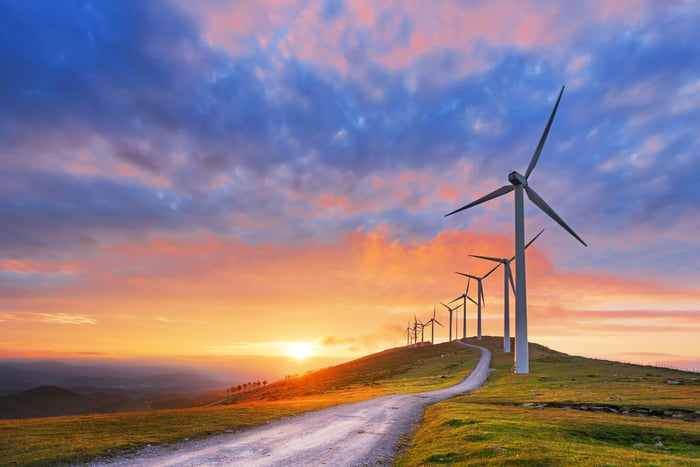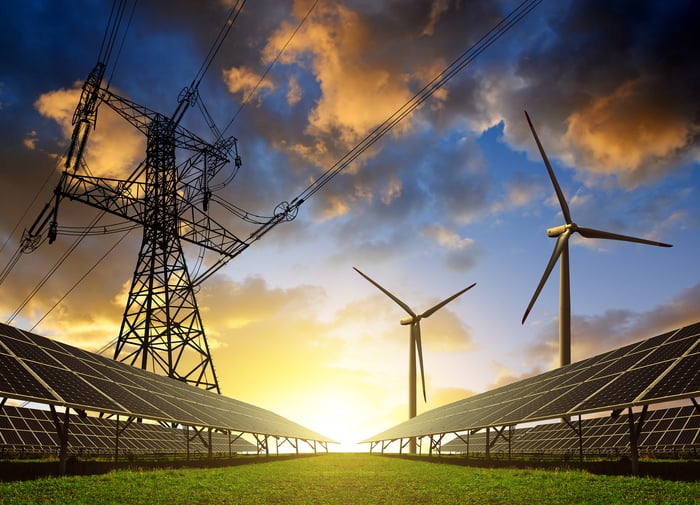Check out the latest Pattern Energy earnings call transcript.
Last year was a tough one for most stocks, as the market sold off over worries about a slowing global economy. However, it was an even rougher one for Pattern Energy (PEGI), whose stock tumbled 13.4%, more than double the loss of the S&P 500. That's because some cracks started forming in the high-yielding renewable energy company's foundation, which caused investors to become concerned about its ability to grow.
That leaves Pattern Energy with a few things on its to-do list for 2019. Here are three it needs to accomplish to ease investors' concerns and win back their support.

Image source: Getty Images.
No. 1: Continue shoring up the balance sheet
Pattern Energy has grown at a fast pace over the past few years by issuing new debt and equity to fund acquisitions. However, all that borrowing has pushed the company's leverage ratio to a concerning level, which forced the company to take action in recent months to improve its financial profile. The company did that by selling a couple of non-core assets, which not only bolstered its balance sheet but also gave it the cash to reinvest in some higher returning opportunities.
While Pattern made solid progress on its asset recycling plan last year, it needs to make even more in 2019. Ideally, the company should continue selling select assets until it has reduced its leverage ratio below its target of less than 3 times corporate debt to earnings. That would enhance its financial flexibility so that it can pursue new growth opportunities that could emerge in the future.
No. 2: Improve dividend coverage
Pattern Energy had been an excellent dividend growth stock, considering it increased its payout in each of its first 15 quarters as a public company. However, the company pressed pause on dividend growth last year, because its payout ratio was around 100% of its cash flow, which left it with no room for error.
The company's aim is to get its payout ratio down to a more comfortable level of 80% of its cash flow. It can do that by continuing the progress of its capital recycling plan. For example, the company sold its K2 Wind power facility in Canada for $166 million, valuing it at 15 times cash flow, and used $23 million of that money to invest in Stillwater Wind in Montana, buying in at about 10 times cash flow. If the company can continue to sell assets for a much higher value than it buys them, then it could quickly reduce leverage as well as its dividend payout level.

Image source: Getty Images.
No. 3: Formalize a sustainable long-term growth strategy
Pattern Energy noted that with access to capital, it has a large enough pipeline of acquisition opportunities to grow cash flow per share at more than an 8% annual pace, with upside into the double digits depending on how much outside financing it can obtain. However, with its share price slumping 13% last year, it's becoming too expensive to issue equity to fund growth. Meanwhile, with its elevated debt level, it can't use more debt to finance growth, either. As a result, the company needs to target a more sustainable expansion plan that doesn't require outside capital.
With the company aiming to improve its dividend coverage ratio to 80%, it will have more retained cash to fund expansion. Add that capital to an improving balance sheet, and Pattern Energy should eventually be in the position if self-funding growth. What it needs to do is provide investors with a better idea of how much it can expand both cash flow and its dividend without having to rely on outside funding once it achieves its targeted leverage and payout ratio. By doing so, it would give investors more confidence in its ability to deliver sustainable growth even if capital market conditions deteriorate, which was the case last year.
Lots to watch in the new year
As attractive as Pattern Energy's 8.4%-yielding dividend might be after last year's sell-off, there are still questions about its long-term sustainability because of the company's high payout ratio and elevated debt levels. However, if the company can address those concerns by completing its to-do list, it would become a much more attractive stock for income-seeking investors. In the meantime, investors should put it on their watch list so that they can keep an eye on its progress.





